Facts about Lightning

The sound of thunder from a lightning strike is prolonged by successive strokes.

Dry lightning is a folk misnomer in common usage in the United States for thunderstorms which produce no precipitation at the surface.

Some European languages have a separate word for lightning that strikes the ground, as opposed to lightning in general—often it is a cognate of the English word "rays."

Singapore has one of the highest rates of lightning activity in the world.
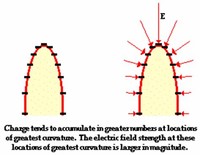
When the electric field becomes strong enough, an electrical discharge (the bolt of lightning) occurs within clouds or between clouds and the ground.

More recently, however, the Cassini-Huygens mission fly-by of Venus detected no signs of lightning at all.

Harry Potter, protagonist in the Harry Potter series of books authored by J.K. Rowling, has a lightning-bolt shaped scar on his forehead.

Scientists and the public have given special names to these various types of lightning.

The wire unwinds as the rocket climbs, making a convenient path for the lightning to use.

Positive lightning, also known colloquially as a "bolt from the blue," makes up less than 5 percent of all lightning.

The Soviet Venera and U.S. Pioneer missions of the 1970s and 1980s sent signals suggesting lightning in the upper atmosphere of Venus.

Charge separation and accumulation continue until the electrical potential becomes sufficient to initiate lightning discharges, which occurs when the gathering of positive and negative charges forms a sufficiently strong electric field.
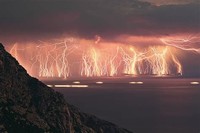
Large quantities of ice in the clouds are suspected to enhance lightning development.

Positive lightning has also been shown to trigger the occurrence of upper atmosphere lightning.

Rocket lightning is a form of cloud discharge, generally horizontal and at cloud base, with a luminous channel appearing to advance through the air with visually resolvable speed, often intermittently.

Bead lightning is a type of cloud-to-ground lightning which appears to break up into a string of short, bright sections, which last longer than the usual discharge channel.

Lightning can also occur within the ash clouds from volcanic eruptions, or can be caused by violent forest fires which generate sufficient dust to create a static charge.

Lightning struck the Apollo 12 soon after takeoff, and has struck soon after thermonuclear explosions .

When a house belonging to one Li Shunju had been struck by lightning, Kuo wrote that everyone assumed that the house would be burnt to the ground.
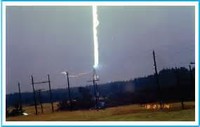
Lightning has been triggered directly by human activity in several instances.

Lightning discharges generate a wide range of electromagnetic radiations, including radio-frequency pulses.

Lightning discharges may occur between areas of cloud having different potentials without contacting the ground.

The voltage difference for positive lightning must be considerably higher, due to the tens of thousands of additional metres/feet the strike must travel.

Different locations have different potentials (voltages) and currents for an average lightning strike.

Roy Sullivan held a Guinness World Record after surviving seven different lightning strikes across 35 years.

Extremely large volcanic eruptions, which eject gases and solid material high into the atmosphere, can trigger lightning.

When a tree acts as a natural lightning conductor, due to skin effect most of the lightning currents flow through the skin of the tree and the sap wood.

The expression "lightning never strikes twice " refers to a highly improbable event.

Several theories have been advanced to describe ball lightning, with none being universally accepted.

Ball lightning has been seen in tornadoes, and it has been seen to split apart into two or more separate balls and recombine.
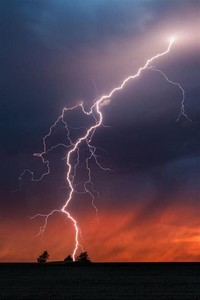
Staccato lightning, which is nothing more than a leader stroke with only one return stroke.

The bolt of lightning in heraldry is called a thunderbolt and is shown as a zigzag with non-pointed ends.

NASA scientists have also found that the radio waves created by lightning clear a safe zone in the radiation belt surrounding the earth.

Various factors affect the probability of lightning strikes at any given location.

Cloud-to-ground lightning is a great lightning discharge between a cumulonimbus cloud and the ground initiated by the downward-moving leader stroke.
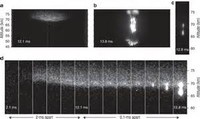
Sprites are sometimes, but not always, preceded by a sprite halo, a broad, pancake-like region of transient optical emission centered at an altitude of about 75 km above lightning.

Ball lightning is typically 20 – 30 cm (8-12 inches) in diameter, but ball lightning several meters in diameter has been reported.

Positive lightning is also now believed to have been responsible for the 1963 in-flight explosion and subsequent crash of Pan Am Flight 214, a Boeing 707.

Subsequently, aircraft operating in U.S. airspace have been required to have lightning discharge wicks to reduce the chances of a similar occurrence.

One is that the observer sees portions of the lightning channel end on, and that these portions appear especially bright.

Tall trees with high biomass for the root system provide good lightning protection.

High speed videos (examined frame-by frame) show that most lightning strikes are made up of multiple individual strokes.

A bolt of lightning can travel at a speed of 45 km/s (kilometers per second) (100,000 mph, 160,000 km/h).

The survey also revealed 48 percent of Californians say religion is "very important," while the figure for the United States is 56 percent.

Benjamin Franklin (1706-1790) endeavored to test the theory that sparks shared some similarity with lightning using a spire which was being erected in Philadelphia.

Lightning requires the electrical breakdown of a gas, so it cannot exist in a visual form in the vacuum of space.

During a positive lightning strike, huge quantities of ELF and VLF radio waves are generated.

An anvil-to-ground lightning bolt is a sign of an approaching storm, and if one occurs in a largely clear sky, it is known colloquially as a "Bolt from the blue".

Ball lightning is described as a floating, illuminated ball that occurs during thunderstorms.

The city of Teresina in northern Brazil has the third-highest rate of occurrences of lightning strikes in the world.

Lightning currents are characterized by a high rate of change, on the order of 40 kA per microsecond.
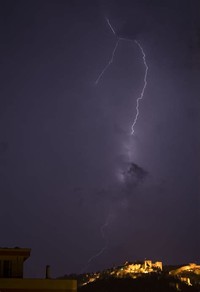
Lightning is an atmospheric discharge of electricity, which typically occurs during thunderstorms, and sometimes during volcanic eruptions or dust storms.

Japanese research shows that ball lightning has been seen several times without any connection to stormy weather or lightning.

The United States federal government has constructed a nation-wide grid of such lightning detectors, allowing lightning discharges to be tracked in real time throughout the continental U.S.

Trees are natural lightning conductors and are known to provide protection against lightning damages to the nearby buildings.

Reports by scientists of strange lightning phenomena above storms date back to at least 1886.

Such triggered lightning is intended to protect rocket launching pads, electric power facilities, and other sensitive targets.

The region of present–day Georgia was settled sometime between 6000 and 5000 B.C.E.

Any complete theory of ball lightning must be able to describe the wide range of reported properties, such as those described in Singer's book The Nature of Ball Lightning and also more contemporary research.
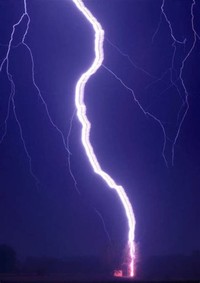
Ribbon lightning occurs in thunderstorms with high cross winds and multiple return strokes.

Scientists and the public have given special names to these various types of lightning.

Ground-to-cloud lightning is a lightning discharge between the ground and a cumulonimbus cloud from an upward-moving leader stroke.

Ball lightning has been described by eyewitnesses but rarely recorded by meteorologists.

The Empire State Building is struck by lightning on average 23 times each year, and was once struck 8 times in 24 minutes.

The role of TGFs and their relationship to lightning remains a subject of ongoing scientific study.

The times at which a pulse from a given lightning discharge arrive at several receivers can be used to locate the source of the discharge.

Culturally, there are various expressions in which lightning is a metaphor for sudden, unusual occurrences.

During a positive lightning strike, huge quantities of ELF and VLF radio waves are generated.
When the positive and negative charges grow large enough, a giant spark - lightning - occurs between the two charges within the cloud. This is like a static electricity sparks you see, but much bigger. Most lightning happens inside a cloud, but sometimes it happens between the cloud and the ground.
Lightning is an electric current. Within a thundercloud way up in the sky, many small bits of ice (frozen raindrops) bump into each other as they move around in the air. All of those collisions create an electric charge. After a while, the whole cloud fills up with electrical charges.
Lightning bolt may refer to: Lightning, a electrostatic discharge during an electrical storm. Lightning strike, an electric discharge between the atmosphere and the ground. Thunderbolt, lightning accompanied by a loud thunderclap.
A lightning rod (US, AUS) or lightning conductor (UK) is a metal rod mounted on a structure and intended to protect the structure from a lightning strike. ... The lightning rod requires a connection to earth to perform its protective function.
Lightning rods were originally developed by Benjamin Franklin. A lightning rod is very simple -- it's a pointed metal rod attached to the roof of a building. ... If lightning strikes, the system attempts to carry the harmful electrical current away from the structure and safely to ground.
Small metal objects will not attract a lightning channel that is further away than a distance equal to the object's length. Lightning would have to strike within three feet of this umbrella before it could be 'attracted' to the umbrella.
6) Lightning can travel through pipes so avoid all plumbing during a thunderstorm. That means no washing your hands, showering or washing dishes. 7) Stay away from any windows. Lightning has been known to strike through glass.Jun 20, 2011
4. You'll Be Struck by Lightning If You Carry an Umbrella (or a BlackBerry) in a Storm. News flash: Metal doesn't attract lightning. Even a lightning rod doesn't—it can only conduct lightning, should a bolt happen to strike nearby.
Lightning Likes Trees. Trees attract lightning because they provide a path for lightning to travel from the storm cloud to the earth. ... Lightning most often strikes oak, elm, pine, tulip, cottonwood, ash, maple, sycamore, hemlock and spruce trees.
Water does not "attract" lightning. It does, however, conduct current very well. It's not clear how far lightning travels through water. People have been killed or injured by direct or indirect strikes while in or on the water, boats, docks, piers, surf, surfboards, canoes, while fishing, and so on.
The safest and most obvious place to be in a thunderstorm is indoors. If lightning strikes a house or a building directly, it will tend to follow the available paths to ground, including the electrical wiring, plumbing, cable or telephone lines, antennas and/or steel framework.






